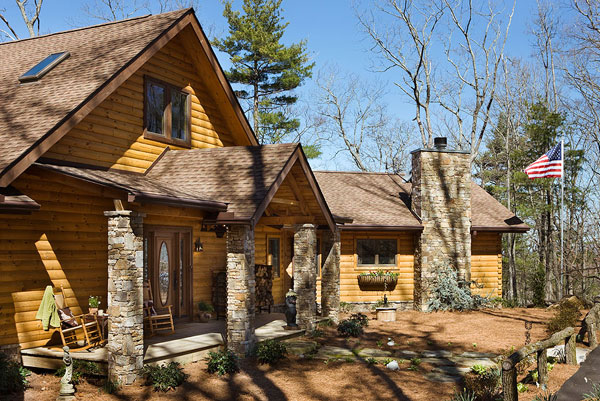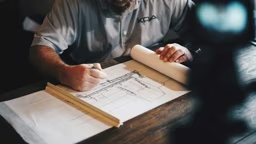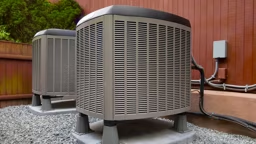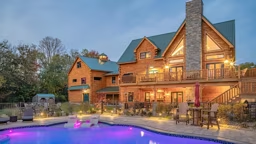Answer the first question with a little help from a lending professional. The other questions should be presented to log home industry representatives—the salespeople and builders you meet.
If you've already selected a log producer, use this list of questions to familiarize yourself with their product specifics. If you're searching for a log producer, you can compare companies by collecting their answers to these questions.
1. How much can you spend?
Every home project involves three variables: cost, size and quality. You can control just two of these factors at any one time: If you choose a large house with high-quality construction and amenities, its cost will be high. Likewise, if you determine the cost and the quality of amenities you prefer, these choices will dictate the home's size.
Taking away one of the variables will help make the log home shopping equation easier to solve. Find out how much you can spend on your dream home by visiting a lender as soon as possible.
2. Who will produce the logs for your home?
This guide will help you choose a log home producer. Some buyers decide after visiting just one company and being impressed with that company's products and staff. Others find a producer by stopping in at a model home or finding the perfect log style and floor plan in a company's plans book.
Consider all your resources. Some log home buyers research and check references before making this important decision. Others may check with the Better Business Bureau, the state attorney general's office or the Log Homes Council. With about 500 log home companies vying for your business, finding one that suits your needs should not be difficult.
Once you've selected a producer, that company will be your ally in attaining your log home dream. The company representative will serve as a terrific resource during your building project, too. You'll have someone to bounce ideas and questions off of, working with the goal of a successful, beautiful log home in mind.
3. How will your home look?
Many log home enthusiasts have a clear vision of their dream home. Others may have a list of priorities but need help arranging those priorities into a floor plan. If you plan to work with an independent designer or architect, it won't be necessary for your log producer to offer design services.
But if you don't have blueprints for your home, you may need a producer with a proven design staff. Similarly, some shoppers have clearer preferences on log styles than others. If you have not already chosen a log producer, your preferences for log style may help narrow your choices.
There may only be a half dozen or so producers in the area where you intend to build that can produce the quality and style of home you want.
4. Who will build your log home?
For the most part, the purchase of a log home material package and the actual construction of the home are entirely different issues. Nevertheless, the matter of who will build the home may influence your decision on the producer and therefore should be part of the buying decision.
Consider whether the company has a group of representatives who also serve as builders, or will you need to find your own local builder for the project? Will the log home producer help your builder assemble the logs?
If you, or someone other than an experienced builder-representative, will build the home, the quality of the producer's technical assistance, construction manual or video becomes crucial.
5. Which wood species will be used?
You will probably want to know what species of wood your home will be built from, because wood species can affect your home's cost and maintenance. There is no "best species" for log homes.
Thousands of beautiful, long-lasting log homes have been built using various wood species. Your choice will probably depend on what species the producer offers or recommends, which species works best with the producer's construction system, as well as the cost differences between species.
6. What profile will your logs have?
To appeal to a variety of customers, most log home producers offer quite an array of log profiles. It's obviously a big decision affecting the final appearance of your log home. Structural differences between the different types of log profiles are relatively insignificant.
What you do want to know before deciding on a log profile is exactly how the logs will look once they are stacked, the height and width of the logs, how butt joints (vertical joints formed where the ends of the logs meet) will look and how the horizontal joints formed where the top and bottom of logs meet will look.
Again the main consideration is that log profile can also dictate the appearance of the home's corner intersections. Trust your own preferences when making this decision, or use the log profile recommended by your producer.
7. Will the logs be precut?
Log packages that are entirely precut can be put together without using a saw or drill. Logs that are not precut will have to be cut to the correct length and notched onsite before they can be placed into the wall.
The matter isn't a question of which system is best; it's truly a question of time and cost. Log packages generally are sold as totally precut, partially precut or random-length packages. You should know which cuts will be made and which holes will be drilled on the job site.
Will your logs be cut to length and completely notched? Can the corners be assembled without further cutting or notching? Are the logs used at gable ends completely precut, or will they need to be cut to the proper angle? Will holes for fasteners or electrical wiring be predrilled?
Again, if you have not already chosen a log home producer, the level of pre-cutting may be very important, especially if you plan to complete some of the construction work yourself.
8. What level of moisture content will the logs have?
The benefits of building with green logs (those with a high moisture content) or logs dried naturally (such as standing- dead logs) or mechanically (kiln-dried logs) are often debated. The fact is that thousands of log homes have been successfully built using either green logs or dried logs. There really is no industry consensus on which is better.
Regardless, to ease any confusion you may have on this issue, consider these questions: Do you understand the effects of a log's moisture content on the method used to construct a log home? Do you believe the producer you have chosen understands the issue and has compensated for the moisture content of the logs in the construction system or materials that will be used?
9. Will your logs be treated?
Many logs are treated with a preservative at the producers' plants. This preservative helps protect logs from discoloration during shipping and erection, and is generally only necessary in warm weather months and in regions that have high humidity.
Other log home producers may apply a long-term, even permanent, preservative treatment. It's important for you to know what preservatives have already been used on your logs, because it will affect both your selection of stains and caulks and your required maintenance tasks in the future.
Ask your producer if your logs will be treated with a preservative treatment intended to prevent deterioration by insects, molds, mildew and fungus attacks, and, if so, how long you can expect this protection to last.
10. What building system will be used on your home?
Many company brochures and catalogs focus on the technical aspects of log building. Though you may feel that you have to master these topics in order to find the perfect log home, remember that while none of these issues is trivial, they should not overwhelm you to the point of indecision or intimidation.
No one building system, wood species or sealing system is so far superior to any other as to make the others unacceptable. Hundreds of companies produce new log homes every year, and few if any use the same combination of methods and materials. Most producers have used their building systems to build hundreds, even thousands, of homes successfully.
In order to more fully understand a producer's building system, you may want to review these points: how the system complies with building codes; what fasteners and sealants are used; how the system accommodates settling; and whether the logs are graded. Producers' sales representatives may focus their pitches on other technical issues as well. While you should carefully consider these issues, try to balance the technical aspects with other equally important issues that affect home buying decisions.
11. How much will the home cost?
This is obviously one of the most important factors in buying a log home. Earlier, you were asked to consider your budget for the project, but here you are looking at a slightly different matter: ensuring that your budget is capable of accommodating the log home that you're planning.
As you compare costs, be aware that several factors come into play when looking at total price and value. For instance, good design will add considerably to the value of your log home. A producer and builder who use materials efficiently will help to keep costs down. And remember that the quality of components in the home should be equal to the value of the home.
A log producer that takes these factors into account will help you get the most for your money, and come in at your budget.
12. What about purchase agreements?
Most purchase agreements are written by log home companies for their protection. The log home companies may amend a contract in segments where they already feel secure, so ask for changes if you need them.
Comparing competitors' contracts will help you identify industry norms so you'll have a better idea of what to expect. Some specific points should be clearly explained in a purchase agreement: the purchase price and payment terms; an itemized list of everything you're buying; a written statement verifying all verbal promises and commitments; the provisions for canceling the contract; and the producer's warranty, as well as the warranty for any products included in the package.
13. What does your log package include?
The bill of materials is a key element of the contract. This portion should contain a very specific, detailed list of the materials and services you are purchasing. The items you should look for on your bill of materials are:
- Wood species for all components, together with the materials grade
- Name of the specific log profile you want
- Degree of pre-cutting of your logs
- Moisture content of your logs as they leave the plant
- Preservative treatment for your logs
- Specific type and quantity of fasteners included with your package
- Specific type, quantity and quality of sealing materials
- Grading certificate for your logs
- Specific quality or grade for all of the components you've purchased
- Number of sets of blueprints included with your package
- Cost of delivery, if it is included in the package
- Cost of each of the items on the bill of materials, so you can compare these costs to the cost of components purchased locally.
14. How will the delivery of your logs be handled?
Some producers include delivery costs in their package price. Others will add it to the total cost of the package by charging either a flat fee or a fee based on mileage. You may want to know if the logs will be delivered by common carrier or the company's own trucks.
You should ask if the driver will help unload, or if you must supply labor. You may be responsible for inspecting the trucks' route through your property, or on rural roads leading to your property, for bridge heights and weight limits. Ask how much notice you will receive of delivery date and time, and if the truck is late, who will pay for extra man-hours or equipment rental charges.
You'll need to know what kind of equipment will be used to unload the truck and how it will be unloaded: Will the first logs off the truck be the last ones needed for construction? Note how much room will be needed to maneuver the truck and turn it around on the job site.
15. Are you comfortable with the people you've selected?
When choosing any professional to work on your home, you should feel sure you've chosen competent, honest people. Pay attention to gut feelings--and check references and talk to several former clients for reassurance. Remember, you'll work with these professionals for months. Make sure you can communicate well with them. Take the time to make informed, confident decisions.
Adding It Up
Having reviewed and answered all of these questions, you should form a fairly clear picture of where you stand on your log home building project. Any areas where you remain unsure merit further consideration.
You've no doubt come a long way from those initial daydreams, someday envisioning this spectacular home. You've now researched the project and become an educated consumer, moving closer to making your log home a reality. Print this guide for future reference and reassurance.
Good luck!












